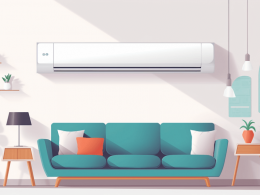Attics, those often overlooked spaces in our homes, are more than just storage areas for sentimental trinkets and old furniture. They play a crucial role in the overall temperature regulation of your home, with an improperly cooled attic leading to an uncomfortable living environment and high energy bills.
If you’ve ever stepped into your attic during the summer months, you’ve probably experienced the sweltering heat that can accumulate there. It’s not just uncomfortable – this heat can seep into the rest of your home, causing your air conditioning system to work harder and leading to increased energy consumption.
In this blog post, we’ll explore the best ways to cool your attic, a task that can seem daunting at first but can yield significant improvements in comfort and cost savings. From understanding why attics get so hot to detailed guidance on insulation and ventilation options and even tips for those who have converted their attic into a livable space – we have got you covered. We’ll also answer common questions and provide expert tips to ensure you’re equipped with the knowledge you need to make your attic and your entire home a cooler place during those hot summer months. Let’s delve in!
Understanding Heat Accumulation in the Attic
Heat accumulation in the attic is a common problem many homeowners face, particularly during the summer months. But why does this occur? Simply put, it’s largely a result of the sun’s rays heating your roof, causing temperatures to spike in your attic. This is due to a phenomenon known as the greenhouse effect, where the heat gets trapped within the enclosed space of the attic, causing the temperature to rise significantly.
This heat doesn’t just stay in your attic. It can permeate down into your living spaces, leading to discomfort and increased use of air conditioning. It can also lead to the deterioration of your roofing materials over time, causing damage that may lead to expensive repairs.
Several signs can tell you if your attic is too hot. One of the most common is if the upper floors of your home are noticeably warmer than the lower levels. Other signs include a spike in your energy bill, particularly during the summer, or if you notice that your air conditioning system is working harder than usual to cool your home.
Knowing how heat accumulates in your attic and the impact it has is the first step to finding the best solution. The next sections will cover insulation and ventilation, two primary methods to help control the temperature in your attic.
The Importance of Proper Insulation
One of the most effective ways to prevent heat accumulation in your attic is by ensuring that it’s well-insulated. But what is insulation, and how does it work?
Insulation refers to materials used in the construction of a house to reduce heat gain or loss. By installing these materials in your attic, you can effectively prevent the hot air in your attic from permeating into the living areas below.
There are different types of insulation materials, each with its own level of effectiveness, measured in R-values. The higher the R-value, the better the material insulates. Common types include fiberglass, cellulose, and foam insulation. Fiberglass is often the most affordable and easiest to install, but foam insulation generally offers higher R-values and better performance.
Apart from keeping your home cool during summer, proper insulation also helps to keep your house warm during the winter by preventing heat from escaping. This is why insulation is a great investment, as it enhances energy efficiency, reduces your heating and cooling costs, and creates a more comfortable living environment year-round.
In the next section, we will discuss another essential factor in maintaining a cool attic: ventilation systems.
Ventilation Systems
While insulation is key to preventing heat transfer into your home, a proper ventilation system plays an equally crucial role in regulating your attic’s temperature. Attic ventilation works by providing a continuous flow of outdoor air through the attic space, helping to remove overheated air and moisture and thus cooling your attic.
There are two types of attic ventilation – natural and mechanical.
Natural ventilation relies on the principle that hot air naturally rises. It uses strategically placed vents to allow fresh, cool air to enter the attic at low points (like soffit or eave vents) and hot air to exit at high points (like ridge or gable vents).
Mechanical ventilation, on the other hand, involves using powered devices like fans to force air circulation. Attic fans, which we’ll discuss more in section V, are a common form of mechanical ventilation.
Choosing the best ventilation system for your attic depends on several factors, including the size and layout of your attic, your local climate, and your specific cooling needs. In many cases, a combination of natural and mechanical ventilation can provide the best results.
Now that we’ve explored insulation and natural ventilation, let’s move on to the installation of attic fans, another potential solution to cooling your attic.
Installation of Attic Fans
Attic fans can be a significant game-changer in the battle against attic heat. They work by expelling hot air from the attic and drawing in cooler outside air through vents. This process reduces the overall temperature in the attic and prevents heat transfer to the lower levels of your home.
There are primarily two types of attic fans – electric and solar. Electric attic fans are more common and can be wired to your home’s electrical system. Some models can also be connected to a thermostat, which will automatically turn the fan on and off based on a set temperature.
Solar attic fans, on the other hand, run on solar power and are an eco-friendly option. They are ideal for homeowners looking to reduce their energy consumption and benefit from renewable energy. However, their performance can be influenced by the availability of sunlight.
Installing an attic fan involves selecting a suitable location, cutting a hole in the roof, fitting the fan, and, if it’s an electric model, wiring it to your power system. While it’s possible to do this yourself, hiring a professional is often recommended due to the complexities involved, including working on the roof and dealing with electrical wiring.
In the following section, we will look at another unique solution for cooling your attic – radiant barriers and reflective insulation.
Radiant Barriers and Reflective Insulation
In your quest to cool your attic, you might also consider installing radiant barriers and reflective insulation. These materials work by reflecting radiant heat, reducing the amount of heat that gets transferred from your roof to the attic space.
Radiant barriers are typically made of a highly reflective material, often aluminum foil, which is applied to one or both sides of a number of substrate materials. These substrates can be kraft paper, plastic films, cardboard, or oriented strand board (OSB).
Reflective insulation, on the other hand, incorporates a reflective surface with an insulating material to combine the benefits of radiant heat reflection and insulation.
These materials are most effective in hot climates where cooling expenses are a significant portion of energy costs, and they can be especially beneficial if your attic doesn’t have much insulation. However, their performance can be significantly reduced if they get dusty or dirty over time, so occasional maintenance is necessary.
Installing radiant barriers or reflective insulation involves securing the material across the bottom of your roof rafters. While it’s a project you could potentially undertake on your own, a professional installer may be able to ensure the best results.
In the next section, we’ll look at the considerations to bear in mind when it comes to cooling an attic that has been converted into a living space.
Attic Conversion and its Effect on Cooling
An attic conversion is an excellent way to add additional living space to your home. Whether it’s a new bedroom, home office, or a leisure space, converting your attic into a functional area can significantly enhance the value and utility of your home. However, this change also brings with it a new set of challenges when it comes to cooling.
Attic conversions tend to generate more heat due to increased human activity and the potential addition of heat-generating appliances. Further, the additional walls and surfaces in a converted attic can inhibit the flow of air, potentially making the space hotter than a non-converted attic.
Tips for effectively cooling an attic conversion

Ensure adequate insulation: As with a standard attic, proper insulation is key to maintaining a comfortable temperature in an attic conversion. Consider installing insulation not only on the attic floor but also in the new walls and ceiling.
Install an independent air conditioning unit: Depending on the size and use of the converted space, you might need an additional, independent air conditioning unit. This will allow you to control the temperature in the attic without affecting the rest of the house.
Use light-colored finishes: Light colors reflect more sunlight than darker ones, reducing the amount of heat that is absorbed by walls, floors, and ceilings.
Incorporate adequate ventilation: Ensure that the converted space has proper ventilation to encourage airflow. This could be through the use of windows, vents, or even the addition of ceiling fans.
Expert Tips for Cooling Your Attic
Efficiently cooling your attic goes beyond just installing insulation or an attic fan. Here are some additional tips and tricks from industry professionals to help you keep your attic, and therefore your entire home, cooler.
Regular Maintenance
Inspect your attic regularly to make sure the insulation is in good condition, the vents are not blocked, and the radiant barriers are free of dust. This will ensure these systems work effectively.
Consider Energy-Efficient Roofing
Reflective roofing materials can help reflect more sunlight, reducing the amount of heat that gets transferred into your attic.
Seal Air Leaks
Air leaks can undermine your insulation by allowing cool air to escape and hot air to enter. Be sure to check for and seal any air leaks in your attic.
Properly Size Your Cooling Systems
If you’re installing an attic fan, make sure it’s properly sized for your space. An undersized fan won’t cool efficiently, while an oversized fan can create negative pressure that draws conditioned air from your home into the attic.
Check Building Regulations
Before undertaking major projects like installing an attic fan or radiant barriers, check your local building regulations. Some projects may require a permit or have specific guidelines to ensure safety and efficiency.
Seek Professional Advice
If in doubt, seek advice from a professional. An energy auditor or HVAC professional can help you identify the best solutions for your specific situation, ensuring you get the most efficient and cost-effective results.
Conclusion: The Benefits of a Cool Attic
Efficiently cooling your attic is a crucial aspect of maintaining a comfortable living environment in your home. Not only does it prevent your living spaces from getting uncomfortably warm, but it also reduces the strain on your air conditioning system, leading to lower energy costs. In addition, a cool attic can also prolong the life of your roofing materials, potentially saving you from expensive repairs in the future.
To recap, some of the best ways to cool your attic include:
- Installing proper insulation to reduce heat transfer.
- Ensuring adequate ventilation to encourage airflow.
- Installing an attic fan to expel hot air and draw in cooler air.
- Using radiant barriers and reflective insulation to reflect heat away from your attic.
- For attic conversions, considering additional measures like independent air conditioning units and light-colored finishes.
Remember that each home is unique, and what works best for you may depend on your specific situation, including the size and layout of your attic, your local climate, and your budget. Consider seeking advice from a professional to ensure you’re getting the most efficient and effective solution.
Investing in the cooling of your attic might seem like a daunting task at first, but the benefits in terms of comfort, energy efficiency, and cost savings make it worthwhile. With the right knowledge and resources, you can transform your attic from a hot, underutilized space to a cool and efficient part of your home’s overall temperature regulation system.
We hope that this guide has provided you with valuable insights and practical tips to cool your attic effectively. Stay cool and enjoy a more comfortable home!
Frequently Asked Questions about Cooling an Attic
Does a hot attic affect the rest of my house?
Yes, heat from your attic can permeate into the living spaces below, making your home warmer and your air conditioning system work harder. This not only leads to an uncomfortable living environment but also higher energy costs.
What is the ideal temperature for my attic?
The temperature of your attic should ideally be close to the outside temperature. If it’s significantly hotter, it may indicate poor insulation or inadequate ventilation.
Can I cool my attic by simply installing more vents?
While more vents can help improve air circulation, they may not be sufficient on their own to significantly reduce attic temperature. A combination of proper insulation, efficient ventilation, and potentially an attic fan is usually the most effective solution.
Is a powered attic fan better than natural ventilation?
It depends on the specifics of your attic and the local climate. In some cases, natural ventilation might be sufficient. However, in hotter climates or attics with poor natural ventilation, a powered attic fan can be more effective.
Do radiant barriers and reflective insulation work in all climates?
These materials are most effective in hot climates where the sun heats the roof significantly. In cooler climates, their benefits may be less noticeable, though they can still contribute to overall insulation.
Do I need to maintain my attic cooling systems?
Yes, maintenance is key to ensuring your attic cooling systems work effectively. This could involve cleaning dust off radiant barriers, checking insulation for any signs of damage, and ensuring vents are not blocked.










